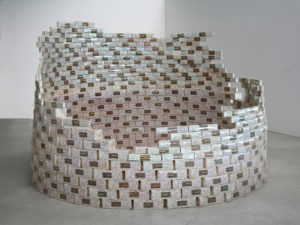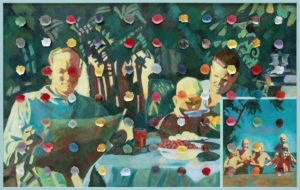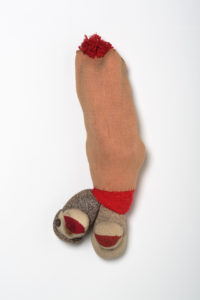With the works of private collectors it would be possible to make the best of contemporary art museums. This is especially true for our country, which has started to have museums of contemporary art regularly active and scattered throughout the territory only for a few decades. In Italy, more than elsewhere, for a long time private collecting has governed the economy of the world of contemporary art, galleries and artists. Since the nineties, private collectors have also begun to become extroverted here, gradually making themselves available to offer themselves to the public, in some cases creating spaces with permanent activity. I am referring to foundations. A super museum can be created by taking works on loan from different private collections. According to an “exhibition writing” (the expression is by Harald Szeemann) a concrete history of art could be traced, alive in presenting itself to the viewer, as a great analogical operation in the digital age.
The exhibition We are the revolution can be considered an experiment for such a museum solution. It is in Piacenza until May 24, 2020, curated by Alberto Fiz, in a new cultural center, the XNL Piacenza Contemporanea, the former Enel headquarters from which the name derives, as well as in the Ricci Oddi Gallery. The title appropriates the words of Joseph Beuys to refer to a different radical change, possible thanks to collectors: the making available to the public of a wealth of works of art usually precluded because private. The “revolutionaries” involved for the occasion are Claudia and Enrico Consolandi (with the late Paolo behind them), Gemma De Angelis Testa, Mauro De Iorio, Ernesto Esposito, Giorgio Fasol, Bruna Girodengo and Matteo Viglietta, Giovanni Floridi, Giovanni Giuliani, Giuliano Gori, Tullio and Simona Leggeri, Emilio and Luisa Marinoni, Laura Mattioli, Domenica Rosa Mazzolini, Claudio Palmigiano and Maria Grazia Longoni, Pierluigi and Natalina Remotti, Patrizia Sandretto Re Rebaudengo, Stefano Sciarretta and Raffaella Frascarelli, Giuliana and Tommaso Setari.
More than one hundred and fifty works are exhibited, most of them signed by worldwide recognized artists. There are some works by artists that emerged in the first half of the twentieth century, but there are above all numerous works by artists of the last generations.
The exhibition is divided into eight sections, such as “Domestic alterations”, “The other seen by itself”, quite stringent, or more open as “Enigma”, “Explorations”, temporary but somewhat artificial definitions. It is true that these do not respond to traditional historical compartments and in transversality they can recall an updated museology, as a laboratory hypothesis for a museum being set up. In reality, in museums and in today’s art centers, installations based on the use of panels are almost never used, as in this case, among other things, on the project of an important studio, by Michele De Lucchi and AMDL Circle, where the works are not used to the fullest and the distinctions between sections become blurred. The sections work quite well in the catalog that accompanies the exhibition, edited by Fiz himself, a very accurate volume (Silvana Editoriale), useful, which includes interviews with collectors and expert essays.
For the artists we go from Giorgio de Chirico to Keith Haring, from Piero Manzoni to Andy Warhol, from Sol LeWitt to Maurizio Cattelan, from Francesco Clemente to Mario Airò, from Tomás Saraceno to Pietro Roccasalva, from Piero Manzoni to Lara Favaretto, from Gabriele Basil to Mona Hatoum, from Georg Baselitz to Nan Goldin. Among the exhibited works there are goodies, rarities or discoveries even for connoisseurs: to give examples, a retractable object (1967) by Emilio Prini, or a four-handed spatial concept (1966) by Lucio Fontana and Hisaschika Takahashi.
The vocation of the XNL does not seem to be that of space with a permanent collection, it is a multipurpose cultural center. However, the exhibition includes a stable, site-specific work that Giuseppe Penone has created for the occasion.
Info:
We are the revolution. Contemporary Italian collecting
(La rivoluzione siamo noi. Collezionismo italiano contemporaneo)
1 February – 24 May 2020
curated by Alberto Fiz
XNL Piacenza Contemporanea
via Santa Franca 36, 29121 Piacenza
 Aldo Mondino, Torre di torrone, 1968, nougat boxes (wood and paper), 180×260, La Gaia Collection
Aldo Mondino, Torre di torrone, 1968, nougat boxes (wood and paper), 180×260, La Gaia Collection
 Ilya Kabakov, Holiday#5, 2014, oil on canvas, 100,5x160x8,Ernesto Esposito Collection
Ilya Kabakov, Holiday#5, 2014, oil on canvas, 100,5x160x8,Ernesto Esposito Collection
 Mike Kelley, Sackmates, 1989, stuffed animals felt, cm 52x20x14, La Gaia Collection
Mike Kelley, Sackmates, 1989, stuffed animals felt, cm 52x20x14, La Gaia Collection

is a contemporary art magazine since 1980






NO COMMENT